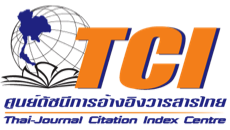ผลการจัดการเรียนรู้โดยใช้กระบวนการทางภูมิศาสตร์ที่มีต่อทักษะการหาความสัมพันธ์ของสเปสกับสเปสและสเปสกับเวลาในเด็กปฐมวัย (The Effects of Geographic Inquiry Learning Provision on Time – Space Relationship Skill of Young Children)
คำสำคัญ:
กระบวนการทางภูมิศาสตร์, ทักษะการหาความสัมพันธ์ของสเปสกับสเปสและสเปสกับเวลา, เด็กปฐมวัยบทคัดย่อ
การวิจัยครั้งนี้มีวัตถุประสงค์เพื่อศึกษาผลการจัดการเรียนรู้โดยใช้กระบวนการทางภูมิศาสตร์ที่มีต่อทักษะการหาความสัมพันธ์ของสเปสกับสเปสและสเปสกับเวลาในเด็กปฐมวัย กลุ่มประชากรในการวิจัยครั้งนี้ คือ เด็กปฐมวัยอายุระหว่าง 5-6 ปี ที่กำลังศึกษาอยู่ในระดับชั้นอนุบาลปีที่ 3 ภาคเรียนที่ 2 ปีการศึกษา 2563 โรงเรียนวัดพระพุทธฉาย จำนวน 24 คน เครื่องมือที่ใช้ในการวิจัยครั้งนี้ ประกอบด้วย แผนการจัดประสบการณ์การเรียนรู้โดยใช้กระบวนการทางภูมิศาสตร์ จำนวน 24 แผน แบบบันทึกพฤติกรรมทักษะการหาความสัมพันธ์ของสเปสกับสเปสและสเปสกับเวลาในเด็กปฐมวัย และแบบประเมินทักษะการหาความสัมพันธ์ของสเปสกับสเปสและสเปสกับเวลาในเด็กปฐมวัย วิเคราะห์ข้อมูลโดยใช้ค่าเฉลี่ย และค่าเบี่ยงเบนมาตรฐาน และการวิเคราะห์ข้อมูลเชิงคุณภาพโดยการวิเคราะห์เนื้อหาและบรรยายเชิงพรรณนา ผลการวิจัยพบว่า เด็กปฐมวัยที่ได้รับการจัดการเรียนรู้โดยใช้กระบวนการทางภูมิศาสตร์มีคะแนนทักษะการหาความสัมพันธ์ของสเปสกับสเปสและสเปสกับเวลาหลังการทดลองสูงขึ้นกว่าก่อนทดลอง โดยพบว่าหลัง การทดลองเด็กสามารถบอกตำแหน่งที่อยู่ของสิ่งต่าง ๆ โดยใช้คำศัพท์ ซ้าย ขวา ด้านหน้า ด้านหลัง และระหว่าง สามารถอธิบายความสัมพันธ์ของสิ่งของ สถานที่กับบุคคลและสิ่งแวดล้อมได้ สามารถอธิบายและวาดภาพความสัมพันธ์ระหว่างสื่อ 2 มิติ กับ 3 มิติ และสามารถอธิบายความสัมพันธ์ของการเปลี่ยนแปลงตำแหน่งที่อยู่ หรือลักษณะของสิ่งของและสถานที่ที่มีความเกี่ยวข้องกับเวลาได้
References
Flynn, C. T. (2018). Mapping a Learning Trajectory and Student Outcomes in Unplugged Coding: a Mixed Methods Study on Young Children's Mathematics and Spatial Reasoning. [online] Retrieved May 12, 2021, from https://www-proquest-com.portal. lib.ku.ac.th/pqdtglobal/docview/2046837523/E45EB71BF9FC4D99PQ/1?accoun tid=48250.
Fromboluti, C. S. and Seefeldt, C. (1999). Early Childhood: Where Learning begins Geography with Activities for Children Ages 2 to 5 Years of Age. [Online]. Retrieved January 3, 2021, from http://teacherlink.ed.usu.edu/tlresources/reference/geography.pdf.
Jantra, K. (2020). Learning Management for Geo-literacy in Social Studies. [Online]. Retrieved December 19, 2020, from http://academic.obec.go.th/images/mission/1524627007_d_1.pdf. (in Thai)
Ministry of Education. (2020) Early Childhood Curriculum B.E. 2560 [A.D. 2017] Handbook for 3 – 6 Years Old. [Online]. Retrieved December 19, 2020, from http://academic. obec.go.th/images/document/1572317514_d_1.pdf. (in Thai)
Phornphisutthimas, S. (2008). “Teaching Science with an Emphasis on Process Skills”. Advanced Science Journal 8(2): 28 – 38. (in Thai)
The Institute for the Promotion of Teaching Science and Technology. (2020). How To Find Relationship Time-Space. [Online]. Retrieved January 3, 2021, from https://www. scimath.org/video-science/item/8119-2018-05-07-07-06-33. (in Thai)
_______. (2020). How To Find Relationship Space-Space. [Online]. Retrieved January 3, 2021, from https://www.scimath.org/video-science/item/8119-2018-05-07-07-06-33. (in Thai)
_______. (2020). Learning Frameworks and Guidelines for Organizing Experiences Learn to Integrate Science, Technology and Mathematics at the Early Childhood Level. According to the Curriculum of Early Childhood Education, B.E. 2560. [Online]. Retrieved April 1, 2021, from https://www.scimath.org/ebook-science/item/11322-2020-03-05-01-33-35. (in Thai)
Samahito, C. (2020). Handout Course on Development and Leaning in Young Children. Kasetsart University. (in Thai)
Srithong, M. (2011). The Effects of Children as Researchers Learning on the Environment Conservation Knowledge of Preschool Children. Master of Education Thesis Program in Early Childhood Education Graduate School Kasetsart University. (in Thai)




